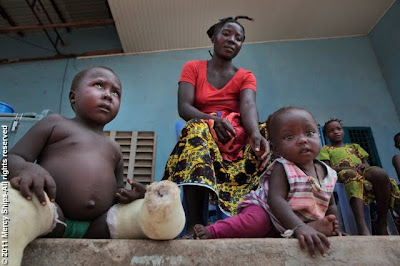
Margaret eight years old sat quietly on the wooden bench beside her dad waiting her turn to be seen at first glance of Margaret one would not be able to divert their eyes from her protruding left eye.
From spending time in Africa and seeing the many patients that come and go the immediate thought on seeing the protruding eye is a Retinoblastoma or Burkette's Lymphoma. A retinoblastoma is a life stealing childhood cancer; Burkette's Lymphoma is a very treatable child hood cancer. When Margaret's turn approached a closer examination was given; due to there being no primary tumour in my mind I ruled out Burkette's lymphoma, my heart was troubled to think "Retinoblastoma." With a little prompting Margaret flashed me a smile and won my heart. I brought her on the ship after speaking with the surgeons Margaret received a comb beam exray for further diagnosis. From the comb beam the surgeons decided it was most likely not a Retinoblastoma, Praise God! She was a surgical candidate. So after a long day of waiting, talking and playing Margaret went home with a return date for surgery. Throughout the day as I had opportunity to speak with her dad. He stated that Margaret had not yet attended school because the other children teased her unmercifully. He stated he had started to teach her as much as he could at home. Which was evident when we checked her vision in the affected eye and she promptly counted the fingers I had raised. On their return to the ship Margaret received her long maticoulous surgery in order to remove the growth behind her eye to maintain her vision and all her other facial nerves.
After Margaret returned to the Intensive care unit on the ship she looked in the mirror and said "Now the other children will want to play with me they will no longer tease me."
Now the waiting for the histology report to come back to find out what indeed was removed from behind her eye. The histogy report has come back as psammomatoid juvenile ossifying fibroma, good news it is benign.




















